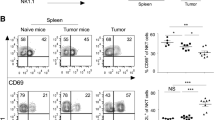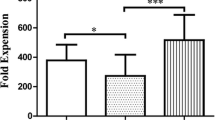Summary
In the present study we investigated some of the physicochemical properties of macrophage-activating factor(s) (MAF) produced by the tumor-immune Lyt-1+2− T cell subset. Supernatant from mixed culture of spleen and lymph node cells, obtained from C3H/HeN mice immunized with syngeneic MH134 hepatoma or MCH-1-A1 fibrosarcoma, with the corresponding tumor cells exhibited the capability of activating peritoneal exudate macrophages to exert their cytostatic and cytolytic activities on tumor cells. Such MAF production was abolished by treatment of tumor-immune spleen and lymph node cells with anti-Thy-1.2 or anti-Lyt-1.1 antibody plus complement (C) before culturing. Anti-Lyt-2.1 and/or anti-asialo GM1 plus C treatment, however, had only marginal effect on the generation of MAF by these cells, despite the complete disappearance of natural killer (NK) cell activity of spleen and lymph node cells after the treatment with anti-asialo GM1 plus C. Thus, the tumor-specific Lyt-1+2− T cell subset could fulfill a crucial role in generating MAF without the support of NK cells. The MAF activity was heat, acid, and trypsin sensitive. On Sephacryl S-300 column, MAF activity was eluated in a broad single peak around a molecular weight (m.w.) of 70,000 daltons. Antiviral activity was detected in the concentrated pool of MAF-containing fractions from Sephacryl S-300. Gel permeation analysis using HPLC also showed a coincident peak of MAF and antiviral activities at a m.w. of approximately 70,000 daltons. In addition, MAF activity was almost completely neutralized by incubation with rabbit antiserum against recombinant murine γ-interferon (IFNγ). Taken together, these results indicate that MAF generated by tumor-immune Lyt-1+2− T cell subset is closely related to IFNγ.
Similar content being viewed by others
References
Benjamin WR, Steeg PS, Farrar JJ (1982) Production of immune interferon by an interleukin 2-independent murine T cell line. Proc Natl Acad Sci USA 79:5379
Cohen S (1980) Lymphokines in delayed hypersensitivity: In: Fougereau M, Dausset J (eds) Progress in immunology, 4. Academic Press, New York, p 860
Conta BS, Powell MB, Ruddle NH (1983) Production of lymphotoxin, IFN-γ and IFN-α,β by murine T cell lines and clones. J Immunol 130:2231
Erickson KL, Cicurel L, Gruys E, Fidler IJ (1982) Murine T cell hybridomas that produce lymphokine with macrophage-activating factor activity as a constitutive product. Cell Immunol 72:195
Fujiwara H, Hamaoka T, Teshima K, Aoki H, Kitagawa M (1976) Preferential generation of killer or helper T-lymphocyte activity directed to the tumor-associated transplantation antigens. Immunology 31:239
Fujiwara H, Fukuzawa M, Yoshioka T, Nakajima H, Hamaoka T (1984) The role of tumor-specific Lyt-1+2− T cells in eradicating tumor cell in vivo. I. Lyt-1+2− T cells do not necessarily require recruitment of host's cytotoxic T cell precursors for implementation of in vivo immunity. J Immunol 133:1671
Fujiwara H, Takai Y, Sakamoto K, Hamaoka T (1985) The mechanism of tumor growth inhibition by tumor-specific Lyt-1+2− T cells. I. Antitumor effect of Lyt-1+2− T cells depends on the existence of adherent cells. J Immunol 135:2187
Fukuzawa M, Fujiwara H, Yoshioka T, Itoh K, Hamaoka T (1984) Effector cell analysis of tumor cell rejection in vivo in two syngeneic tumor systems exhibiting distinct in vitro cytotoxic mechanisms. Gann 75:912
Gray PW, Goeddel DV (1983) Cloning and expression of murine immune interferon cDNA. Proc Natl Acad Sci USA 80:5842
Greenberg PD, Cheever MA, Fefer A (1981) Eradication of disseminated murine leukemia by chemoimmunotherapy with cyclophosphamide and adoptively transferred immune syngeneic Lyt-1+2− lymphocytes. J Exp Med 154:952
Gribaudo G, Cofano F, Prat M, Landolfo S (1985) Monoclonal antibodies to murine interferon-γ: Affinity purification and molecular characterization of murine interferon-γ. J Interferon Res 5:199
Grimm EA, Mazumder A, Zhang HZ, Rosenberg SA (1982) Lymphokine-activated killer cell phenomenon. Lysis of natural killer-resistant fresh solid tumor cells by interleukin 2-activated autologous human peripheral blood lymphocytes. J Exp Med 155:1823
Guerne P-A, Piguet P-F, Vassalli P (1983) Positively selected Lyt-2+ and Lyt-2− mouse T lymphocytes are comparable, after Con A stimulation, in release of IL 2 and of lymphokines acting on B cells, macrophages, and mast cells, but differ in interferon production. J Immunol 130:2225
Handa K, Suzuki R, Matsui H, Shimizu Y, Kumagai K (1983) Natural killer (NK) cells as a responder to interleukin 2 (IL 2). II. IL 2-induced interferon γ production. J Immunol 130:988
Havell EA, Spitalny GL, Patel PJ (1982) Enhanced production of murine interferon γ by T cells generated in response to bacterial infection. J Exp Med 156:112
Kasai M, Iwamori M, Nagai Y, Okumura K, Tada T (1980) A glycolipid on the surface of mouse natural killer cells. Eur J Immunol 10:175
Kelker HC, Le J, Rubin BY, Yip YK, Nagler C (1983) Three molecular weight forms of natural human interferon-γ revealed by immunoprecipitation with monoclonal antibody. J Biol Chem 259:4301
Kelso A, Glasebrook AL (1984) Secretion of interleukin 2, macrophage-activating factor, interferon, and colony-stimulating factor by alloreactive T lymphocyte clones. J Immunol 132:2924
Kelso A, MacDonald HR (1982) Precursor frequency analysis of lymphokine-secreting alloreactive T lymphocytes. Dissociation of subsets producing interleukin 2, macrophage-activating factor, and granulocyte-macrophage colony-stimulating factor on the basis of Lyt-2 phenotype. J Exp Med 156:1366
Kleinschmidt WJ, Schultz RM (1982) Similarities of murine gamma interferon and the lymphokine that render macrophages cytotoxic. J Interferon Res 2:291
Kniep EM, Domzig W, Lohmann-Matthes M-L, Kickhoffen B (1981) Partial purification and chemical characterization of macrophage cytotoxicity factor (MCF, MAF) and its separation from migration inhibitory factor (MIF). J Immunol 127:417
Krammer PH, Echtenacher B, Gemsa D, Hamann U, Hultner L, Kaltmann B, Kees U, Kubelka C, Marcucci F (1983) Immune-interferon (IFN-γ), macrophage-activating factors (MAFs), and colony-stimulating factors (CSFs) secreted by T cell clones in limiting dilution microcultures, long-term cultures, and by T cell hybridomas. Immunol Rev 76:5
Krammer PH, Kubelka CF, Falk W, Ruppel A (1985) Priming and triggering of tumoricidal and schistosomulicidal macrophages by two sequential lymphokine signals: Interferon-γ and macrophage cytotoxicity inducing factor 2. J Immunol 135:3258
Kuribayashi K, Gillis S, Kern DE, Henney CS (1981) Murine NK cell cultures: Effect of interleukin 2 and interferon on cell growth and cytotoxic activity. J Immunol 126:2321
Landolfo S, Kirchner H, Simon MM (1982) Production of immune interferon is regulated by more than one T cell subset: Lyt-1,2,3 and Quat-5 phenotypes of murine T lymphocytes involved in IFN-γ production in primary and secondary mixed lymphocyte reaction. Eur J Immunol 12:295
Leclerc JC, Cantor H (1980) T cell-mediated immunity to oncornavirus-induced tumors. II. Ability of different T cell sets to prevent tumor growth in vivo. J Immunol 124:851
Leonard EJ, Ruco LP, Meltzer MS (1978) Characterization of macrophage activation factor, a lymphokine that causes macrophages to become cytotoxic for tumor cells. Cell Immunol 41:347
Mannel DN, Falk W (1983) Interferon-γ is required in activation of macrophages for tumor cytotoxicity. Cell Immunol 79:396
Marcucci F, Waller M, Kirchner H, Krammer P (1981) Production of immune interferon by murine T-cell clones from long-term cultures. Nature 291:79
Meltzer MS, Benjamin WR, Farrar JJ (1982) Macrophage activation for tumor cytotoxicity: Induction of macrophage tumoricidal activity by lymphokines from EL-4, a continuous T cell line. J Immunol 129:2802
Morris AG, Lin Y-L, Askonas BA (1982) Immune interferon release when a cytotoxic T-cell line meets its correct influenza-infected target cell. Nature 295:150
Nakajima H, Fujiwara H, Takai Y, Izumi Y, Sano S, Tsuchida T, Hamaoka T (1985) Studies on macrophage-activating factor (MAF) in antitumor immune responses. I. Tumor-specific Lyt-1+2− T cells are required for producing MAF able to generate cytolytic as well as cytostatic macrophages. J Immunol 135:2199
Osborne LC, Georgiades JA, Johnson HM (1979) Large-scale production and partial purification of mouse immune interferon. Infect Immun 23:80
Osborne LC, Georgiades JA, Johnson HM (1980) Classification of interferons with antibody to immune interferon. Cell Immunol 53:65
Pace JL, Russell SW, Torres BA, Johnson HM, Gray PW (1983) Recombinant mouse γ interferon induces the priming step in macrophage activation for tumor cell killing. J Immunol 130:2011
Ratliff TL, Thomasson DL, McCool RE, Catalona WJ (1982) T cell hybridoma production of macrophage activation factor (MAF). I. Separation of MAF from interferon gamma. J Reticuloendothel Soc 31:393
Rinderknecht E, O'Connor BH, Rodriguez H (1984) Natural human interferon-γ. J Biol Chem 259:6790
Roberts WS, Vasil A (1982) Evidence for the identity of murine gamma interferon and macrophage activating factor. J Interferon Res 2:519
Sakamoto K, Fujiwara H, Nakajima H, Yoshioka T, Takai Y, Hamaoka T (1986) Requirements of adherent cells for activating Lyt-1+2− T cells as well as for functioning as antitumor effectors activated by factor(s) from Lyt-1+2− T cells. Gann 77:1142
Schreiber RD, Pace JL, Russell SW, Altman A, Katz DH (1983) Macrophage-activating factor produced by a T cell hybridoma: Physicochemical and biosynthetic resemblance to γ-interferon. J Immunol 131:826
Schreiber RD, Hicks LJ, Celada A, Buchmeier NA, Gray PW (1985) Monoclonal antibodies to murine γ-interferon which differentially modulate macrophage activation and antiviral activity. J Immunol 134:1609
Shimizu K, Shen FW (1979) Role of different T cell subsets in the rejection of syngeneic chemically induced tumors. J Immunol 122:1162
Sonnenfeld G, Mandel AD, Merigan TC (1977) The immunosuppressive effect of type II mouse interferon preparations on antibody production. Cell Immunol 34:193
Sonnenfeld G, Mandel AD, Merigan TC (1979) In vitro production and cellular origin of murine type II interferon. Immunology 36:883
Spitalny GL, Havell EA (1984) Monoclonal antibody to murine gamma interferon inhibits lymphokine-induced antiviral and macrophage tumoricidal activities. J Exp Med 159:1560
Svedersky LP, Benton CV, Berger WH, Rinderknecht E, Harkins RN, Palladino MA (1984) Biological and antigenic similarities of murine interferon-γ and macrophage-activating factor. J Exp Med 159:812
Torres BA, Farrar WL, Johnson HM (1982) Interleukin 2 regulates immune interferon (IFNγ) production by normal and suppressor cell cultures. J Immunol 128:2217
Varesio L, Blasi E, Thurman GB, Talmadge JE, Wiltrout RH, Herberman RB (1984) Potent activation of mouse macrophages by recombinant interferon-γ. Cancer Res 44:4465
Weigent DA, Stanton GJ, Johnson HM (1983) Interleukin 2 enhances natural killer cell activity through induction of gamma interferon. Infect Immun 41:992
Author information
Authors and Affiliations
Rights and permissions
About this article
Cite this article
Nakajima, H., Izumi, Y., Sugihara, S. et al. Studies on macrophage-activating factor (MAF) in antitumor immune responses. Cancer Immunol Immunother 25, 201–208 (1987). https://doi.org/10.1007/BF00199148
Received:
Accepted:
Issue Date:
DOI: https://doi.org/10.1007/BF00199148




